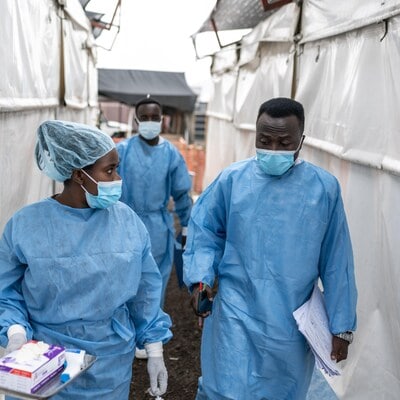Travelers, beware. On August 14, the World Health Organization (WHO) declared the recent surge in Mpox cases a global health emergency. The situation is raising alarm bells, particularly in Africa, where the disease could spread across the continent and beyond.
Since 2022, WHO has reported 99,176 cases of Mpox and 208 deaths in 116 countries. In India, a total of 30 cases have been detected since the 2022 declaration, with the most recent case reported in March 2024.
What is Mpox and how does it spread?
Monkeypox, also known as Mpox, is an infectious disease caused by the monkeypox virus. It manifests with a painful skin rash, swollen lymph nodes, and fever. The virus spreads through close contact with infected people or animals, and transmission is possible through skin lesions, direct skin-to-skin contact, and proximity to an infected person.
What measures are countries taking to protect travelers?
The Indian government has directed airport, port and border authorities to remain alert in response to the global surge in Mpox cases. Central hospitals such as Safdarjung, Ram Manohar Lohia and Lady Hardinge will reportedly be provided with facilities to isolate suspected Mpox cases.
Democratic Republic of the Congo (DRC)
The Democratic Republic of the Congo is currently experiencing its worst Mpox outbreak, with a 160% increase in cases and a 19% rise in deaths compared to last year.
Indonesia
Indonesia’s Ministry of Health has introduced strict health screening protocols for foreign visitors. Travelers must fill out forms disclosing their medical history and recent travel activities upon entering the country. To ensure early detection, the Ministry has designated 12 state laboratories across the country to monitor and identify potential Mpox cases.
Porcelain
Chinese authorities have implemented strict travel restrictions for people showing symptoms of Mpox. Enhanced surveillance measures have been introduced at airports to isolate and test affected travellers. Those showing symptoms such as fever, headache, muscle pain or rash must report their condition upon entry. These measures will remain in place for six months.
South Africa
South Africa has launched a new airport screening initiative aimed at identifying and addressing potential cases of Mpox among travellers arriving into the country. This proactive measure is part of a broader strategy to improve early detection and containment of the virus.
Kenya
Kenya has introduced testing procedures for travellers entering the country in order to identify cases of Mpox and prevent its spread. Although only mild cases have been detected so far, these measures are considered crucial to monitor and manage the outbreak.
Nigeria
Nigeria has implemented a mandatory declaration process for travelers heading to specific African regions. Travelers must complete a declaration form, either at the airport or online, to facilitate tracking and controlling Mpox transmission.
Pakistan
Pakistan’s border health services have called for heightened surveillance and protection measures. Authorities are closely monitoring travellers and implementing rigorous health checks to curb the spread of the Mpox virus.
What should travelers do to avoid getting Mpox?
The U.S. Centers for Disease Control and Prevention (CDC) has issued guidelines for travelers to protect themselves against Mpox infection:
1. If you are eligible, get vaccinated with two doses of Mpox vaccine before you travel. Use the Mpox vaccine locator to find vaccination centres.
2. Avoid close skin-to-skin contact with people who have an Mpox-like rash.
3. Do not touch the rash or scabs of an infected person.
4. Refrain from kissing, hugging, caressing, or having sex with someone who has Mpox.
5. Avoid contact with objects and materials used by an infected person.
6. Do not share eating utensils or cups with someone who has Mpox.
7. Do not handle or touch bedding, towels, clothing, or personal items of an infected person.
8. Wash your hands frequently with soap and water or use an alcohol-based hand sanitizer, especially before eating or touching your face.
What to do if you have Mpox symptoms or have been exposed?
If you have symptoms of Mpox or have been in close contact with someone who has it, talk to your health care provider about testing and treatment. CDC recommends vaccination for those exposed to Mpox or who are at higher risk.
Don’t travel if you have Mpox
If you are infected with Mpox, isolate yourself at home until your symptoms disappear and the rash has completely healed. If you cannot avoid traveling, make sure you do not have a fever or respiratory symptoms and take additional measures to prevent the spread of the virus.
Travelers who test positive for Mpox while abroad may be subject to local public health laws, including isolation requirements. Similarly, those who have been exposed to Mpox may be required to quarantine in accordance with local regulations. It is advisable to consider purchasing travel medical insurance and medical evacuation insurance, as treatment options may be limited in some countries.
According to the European Centre for Disease Prevention and Control (ECDC), travelers planning to visit affected areas should consult their healthcare provider or travel health clinic about vaccination eligibility.
First published: August 22, 2024 | 10:16 am IS
Disclaimer:
The information contained in this post is for general information purposes only. We make no representations or warranties of any kind, express or implied, about the completeness, accuracy, reliability, suitability or availability with respect to the website or the information, products, services, or related graphics contained on the post for any purpose.
We respect the intellectual property rights of content creators. If you are the owner of any material featured on our website and have concerns about its use, please contact us. We are committed to addressing any copyright issues promptly and will remove any material within 2 days of receiving a request from the rightful owner.

